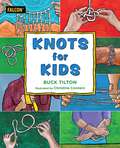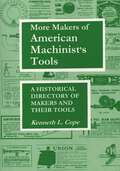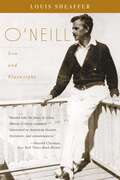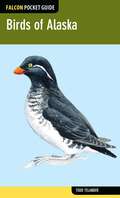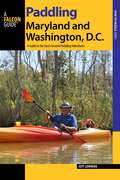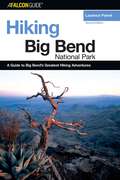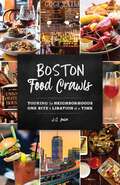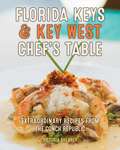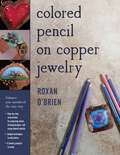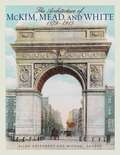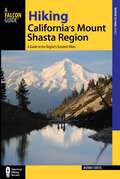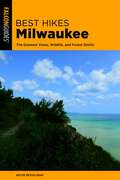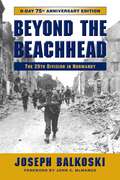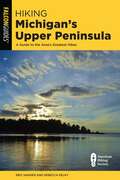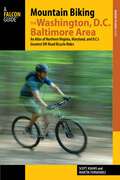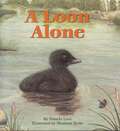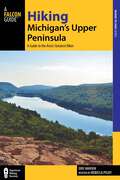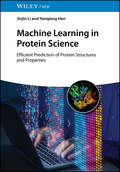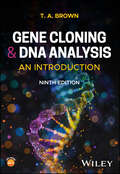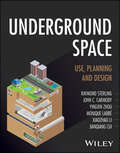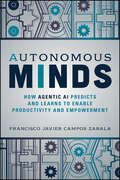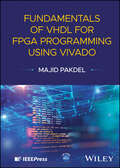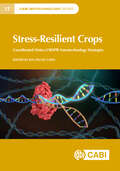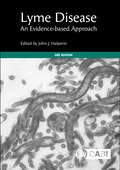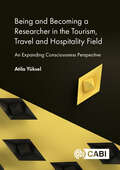- Table View
- List View
Knots for Kids (For Kids)
by Buck TiltonKnots for Kids delivers relevant, expertly curated content perfect for kids. Outdoor skills expert and veteran author Buck Tilton provides readers with accessible information on choosing the best knot for the situation, tying different types of common knots and hitches, selecting the best kinds of rope, and much more. With step-by-step instructions (for both righties and lefties!) on tying the most used and useful knots, this is the perfect book to teach children how to tie knots like the experts.
More Makers of American Machinist's Tools: A Historical Directory of Makers and Their Tools
by Kenneth L. CopeHere is the much-anticipated sequel to the author's Makers of American Machinist's Tools and American Machinist's Tools: An Illustrated Directory of Patents, pioneering works on machinist s tools and their makers. These books together provide the most comprehensive historical directory ever of the machinist tool industry and its technology. This volume covers hundreds of additional makers. There is also new material on the Big Five makers, with several of their previously unknown tools. The research and illustrations in this, and Cope s earlier volumes, provide a truly unique and incomparable reference source for collectors, dealers and researchers.
O'Neill: Son and Playwright
by Louis ScheafferThe most lauded playwright in American history, Eugene O'Neill (1888-1953) won four Pulitzer Prizes and a Nobel Prize for a body of work that includes The Iceman Cometh, Mourning Becomes Electra, Desire Under the Elms, and Long Day's Journey into Night. His life, the direct source for so much of his art, was one of personal tumult from the very beginning. The son of a famous actor and a quiet, morphine-addicted mother, O'Neill had experienced alcoholism, a collapse of his health, and bouts of mania while still a young man. Based on years of extensive research and access to previously untapped sources, Sheaffer's authoritative biography examines how the pain of O'Neill's childhood fed his desire to write dramas and affected his artistically successful and emotionally disastrous life.
Birds of Alaska (Falcon Pocket Guides)
by Todd TelanderBirds of Alaska is a field guide to the most common and sought-after species in the state. Conveniently sized to fit in your pocket and featuring full-color, detailed illustrations, this informative guide makes it easy to identify birds in your backyard, favorite parks, and wildlife areas.
Paddling Maryland and Washington, D.C.: A Guide to the Area's Greatest Paddling Adventures (Paddling Series)
by Jeff LowmanThe rivers of Maryland and Washington, D.C. hold a wealth of splendor from Annapolis to Worcester County. Paddling Maryland and Washington, D.C. features fifty river trips for avid paddlers, floaters, and anglers searching for the perfect paddle, whether it is a half-day or a full-day trip. History buffs will appreciate the sidebars detailing local information. Look inside to find:Full-color photosGPS coordinatesDetailed river descriptionsMaps showing access points and river milesLevel of difficulty, optimal flows, rapids, and other hazardsHistorical informationFor more than twenty-five years, FalconGuides® have set the standard for outdoor guidebooks. Written by top experts, each guide invites you to experience the adventure and beauty of the outdoors.
Hiking Big Bend National Park (Regional Hiking Series)
by Laurence ParentFully updated and revised, this comprehensive guide features forty-seven trails in Big Bend National Park.
Boston Food Crawls: Touring the Neighborhoods One Bite & Libation at a Time (Food Crawls)
by J.Q. LouiseSip and taste your way through Boston. Boston Food Crawls is an exciting culinary tour through this historic yet modern city. Tap into the unique vibes and flavors of neighborhood restaurants and bars. Hit the Theater District for dinner and a show. Just in town for the weekend? Take the classy but sassy crawl through the Back Bay. Lifelong Bostonians will love the Classic Chowder Crawl (did your favorite make the list?), and everyone will find something new on the bonus rooftop crawl. Put on your walking shoes and your stretchy pants, and dig into the Hub one dish at a time.
Florida Keys & Key West Chef's Table: Extraordinary Recipes from the Conch Republic
by Victoria ShearerSurrounded by water, the Florida Keys yields a bounty that easily could qualify as the eighth wonder of the world. The Keys can confidently boast that nowhere else in the continental US will you find fresher, more innovatively prepared fish and seafood. Special natural resources, from stone crabs and yellowtail snapper to cracked conch and key limes, are served any way you like and the relaxed atmosphere of the restaurants is reflected in the cuisine. Be it a roadside cafe or a resort dining room, the cuisine is all &“Keys casual.&” With recipes for the home cook from Florida's most celebrated eateries and showcasing over 200 full-color photos featuring mouth-watering dishes, famous chefs, and lots of local flavor, Florida Keys & Key West Chef's Table is the ultimate gift and keepsake cookbook for both tourists and residents of the Keys.
Colored Pencil on Copper Jewelry: Enhance Your Metalwork the Easy Way
by Roxan O'BrienAt last, an easy way to add gorgeous color to your metalwork without the use of a kiln! Armed with colored pencils and a few simple techniques, you can have the beautiful look of enameled jewelry in much less time.Copper is an affordable option for metalwork, and with the techniques in this book, you can add endless colorful designs to your necklaces, bracelets, earrings, and brooches. By following the illustrated instructions, you will be able to draw and color any design you like onto your jewelry with just a few easy-to-find tools. Give coloring a try on the 10 included projects, or branch out with your own ideas. Once you have mastered the basics, you will have opened a whole new realm of creative options for your jewelry designs.
The Architecture of McKim, Mead, and White: 1879–1915
by Michael George Allan GreenbergFor forty years (1880–1920), the now-legendary architectural firm led by Charles Follen McKim, William Rutherford Mead and Stanford White was responsible for many of the finest buildings in America. The Boston Public Library, Pennsylvania Station in New York, and the campus of Columbia University are among the national landmarks designed by these men and their partners, Bert Fenner and William Mitchell Kendall. This anthology of plans, elevations, and details of major works of McKim, Mead, and White is an invaluable reference source and inspiration for the student of architecture. As Allan Greenberg writes in his introduction: &“The legacy of [McKim, Mead, and White] is so vast that . . . both its outer boundaries and its inner characteristics are only barely discernible. As architects of some of the most important buildings in the history of American architecture, the work of the office of McKim, Mead, and White reached a level of quality which has never been equaled by any large office before or after.&” Charles Follen McKim cofounded the firm with William Rutherford Mead in 1878, along with his brother-in-law William B. Bigelow. One year later, Bigelow left the firm and was replaced by young Stanford White. Among the commissions that McKim worked on were the Villard Houses, the Boston Public Library, the Chicago World&’s Fair Columbian Exposition and the Agriculture Building, the Columbia University campus, Symphony Hall in Boston, alterations to the White House, the Pierpont Morgan Library, Pennsylvania Station, and the University Club in New York. Stanford White, who, ironically, had replaced Charles McKim at the firm of Gambrill and Richardson in New York, joined the partnership in September 1879. A young, enthusiastic man who could &“draw like a house afire,&” in the words of McKim, White was responsible for many of the firm&’s great architectural projects, including Madison Square Garden; the Washington Arch; the Judson Memorial Church; what is now Bronx Community College, and the accompanying Hall of Fame of Great Americans; the Tiffany Building, and the Gorham Building. His life and career ended abruptly at the age of fifty-three, when he was murdered on the roof of Madison Square Garden in a well-publicized shooting incident in 1906.
Hiking California's Mount Shasta Region: A Guide to the Region's Greatest Hikes (Regional Hiking Series)
by Bubba SuessHiking California's Mount Shasta Region covers 50 hikes in the area for hikers of all abilities. Up-to-date trail information and miles and directions will be featured throughout, as well as sidebars on local culture, trivia, and wildlife. GPS coordinates are available for all trailheads.
Best Hikes Milwaukee: The Greatest Views, Wildlife, and Forest Strolls (Best Hikes Near Series)
by Kevin RevolinskiWho says you have to travel far from home to go on a great hike? Best Hikes Near Milwaukee features the best hiking within an hour&’s drive of the Milwaukee area. Perfect for the urban and suburbanite hard-pressed to find great outdoor activities close to home. With these information-packed guides in hand, readers have everything they need for the adventure they seek, from an easy nature walk to a multiday backpacking trip. Detailed maps and trail descriptions make navigating these wonderful trails easy; interesting information about the environment and history of each trail gives hikers a unique insight into the trail that they are exploring. Look inside to find:Hikes suited to every ability Mile-by-mile directional cuesDifficulty ratings, trail contacts, fees/permits, and best hiking seasonsTrail finder chart Information on the area&’s history, geology, flora, and faunaFull-color photos throughout
Beyond the Beachhead: The 29th Infantry Division in Normandy
by Joseph BalkoskiExpanded edition with a new chapter on the final battles of the Normandy campaign By 1945, the US Army had sixty-eight infantry divisions, forty-two of which fought in the great campaign in northwest Europe that began with the amphibious landings on D-Day and ended eleven months later with Germany's surrender. Beyond the Beachhead examines the experience of one infantry division-the 29th-during forty-five days of combat from Omaha Beach on D-Day to the liberation of St. Lô. Using interviews, official records, and unit histories and supplementing his narrative with meticulously detailed maps, Balkoski follows the 29th from the bloody landings at Omaha through the hedgerows of Normandy, illustrating the brutal realities of life on the front line.
Hiking Michigan's Upper Peninsula: A Guide to the Area's Greatest Hikes (State Hiking Guides Series)
by Eric Hansen Rebecca PelkyHiking Michigan&’s Upper Peninsula features fifty of the best hikes in Michigan&’s beautiful Upper Peninsula. Detailed maps and trail descriptions make navigating these wonderful trails easy, from family-friend strolls to popular vistas to hillier wooded pathways. Look inside to find:Hikes suited to every abilityMile-by-mile directional cuesDifficulty ratings, trail contacts, fees/permits, and best hiking seasonsAn index of hikes by category—from easy day hikes to waterfallsInvaluable trip-planning information, including local lodging and campgroundsFull-color photos throughoutGPS coordinates
Mountain Biking the Washington, D.C./Baltimore Area: An Atlas of Northern Virginia, Maryland, and D.C.'s Greatest Off-Road Bicycle Rides (Regional Mountain Biking Series)
by Scott Adams Martin FernandezPlunge down singletrack over the Allegheny Mountains in Maryland, or travel off-road through Virginia&’s scenic horse and wine country with this fully updated and revised Mountain Biking the Washington, D.C./Baltimore Area. Featuring the greatest off-road bicycle rides of Northern Virginia, Maryland, and Washington, D.C., readers will find maps, color photos, GPS coordinates, and much more.
A Loon Alone
by Pamela LoveA tranquil pond becomes a frightening place for a loon chick that is separated from his parents by a menacing snapping turtle. But the brave little bird remains in his hiding place and also survives encounters with a huge moose, a hungry raccoon, and a speedy otter. In the end, he is reunited with his mother and father just as night falls.
Hiking Michigan's Upper Peninsula: A Guide to the Area's Greatest Hikes (Regional Hiking Series)
by Eric HansenHiking Michigan&’s Upper Peninsula features fifty of the best hikes in Michigan&’s beautiful Upper Peninsula. Detailed maps and trail descriptions make navigating these wonderful trails easy, from family-friend strolls to popular vistas to hillier wooded pathways. FalconGuides have set the standard for outdoor guidebooks for more than thirty-five years. Written by top experts, each guide invites you to experience the adventure and beauty of the outdoors. Look inside to find:Hikes suited to every abilityMile-by-mile directional cuesDifficulty ratings, trail contacts, fees/permits, and best hiking seasonsAn index of hikes by category—from easy day hikes to waterfallsInvaluable trip-planning information, including local lodging and campgroundsFull-color photos throughoutGPS coordinates
Machine Learning in Protein Science: Efficient Prediction of Protein Structures and Properties
by Jinjin Li Yanqiang HanHarness the power of machine learning for quick and efficient calculations of protein structures and properties Machine Learning in Protein Science is a unique and practical reference that shows how to employ machine learning approaches for full quantum mechanical (FQM) calculations of protein structures and properties, thereby saving costly computing time and making this technology available for routine users. Machine Learning in Protein Science provides comprehensive coverage of topics including: Machine learning models and algorithms, from deep neural network (DNN) and transfer learning (TL) to hybrid unsupervised and supervised learning Protein structure predictions with AlphaFold to predict the effects of point mutations Modeling and optimization of the catalytic activity of enzymes Property calculations (energy, force field, stability, protein-protein interaction, thermostability, molecular dynamics) Protein design and large language models (LLMs) of protein systems Machine Learning in Protein Science is an essential reference on the subject for biochemists, molecular biologists, theoretical chemists, biotechnologists, and medicinal chemists, as well as students in related programs of study.
Gene Cloning and DNA Analysis: An Introduction
by T. A. BrownNew edition of a world-renowned introductory text to the rapidly-growing and dynamic field of Gene Cloning and DNA Analysis Gene Cloning and DNA Analysis is a comprehensive introductory text that explores all of the topics vital for a complete understanding of gene cloning and DNA analysis. Presented in full color, the text’s easy-to-follow layout and over 250 clear illustrations make the material simple and accessible for a diverse readership. This newly revised and updated Ninth Edition highlights new developments in DNA sequencing technology and provides extended coverage on DNA editing including CRISPR methodology and its applications in gene therapy and plant genetic engineering. This edition also contains updates on topics including optical mapping of DNA molecules, studying transcriptomes in situ, RNA interference methods for silencing genes in crop plants, studying kinship by DNA profiling, and using ancient DNA to study human prehistory and palaeogenomics. Gene Cloning and DNA Analysis also discusses topics such as: The strategies used by researchers and industry practitioners to assemble telomere-to-telomere chromosome sequencesThe synthesis of recombinant vaccines for diseases such as COVID-19 and hepatitis BInterbreeding between Neanderthals and Homo sapiensThe ethical issues raised by the use of gene cloning and DNA editing in pharming, gene therapy and plant genetic modification The Ninth Edition of Gene Cloning and DNA Analysis continues to be an essential reference for undergraduate and graduate students within the fields of genetics and genomics, molecular biology, biochemistry, immunology, and applied biology, as well as professionals in all areas of biological science.
Underground Space: Use, Planning and Design
by John Carmody Xiaozhao Li Yingxin Zhou Raymond L. Sterling Monique Labbé Jianqiang CuiUnlocking the Hidden Potential of Cities from the Ground Down With cities worldwide facing pressures from rapid urbanization, climate change, and land scarcity, underground space has become a vital resource for sustainable and resilient urban development. Underground Space: Use, Planning and Design provides a comprehensive framework for planners, engineers, architects, and policymakers to understand and apply underground solutions and updates a landmark reference work on the topic. Combining many decades of research, practice, and global examples, this book offers authoritative guidance on how underground space can contribute to the creation of livable, future-ready cities. Written by a team of experts from around the globe, Underground Space offers: An understanding of the many reasons why underground space is used and when to choose to build underground.Broad coverage of underground uses, from transport and urban utilities to underground architectural applications.Recent advances made in three-dimensional urban underground planning.Updated design approaches and human-centered considerations for the exterior and interior design, layout, lighting, and safety of underground spaces.In-depth exploration of sustainability, resilience, and adaptability issues.Insights from several decades of hands-on experience with modern underground designs. Underground Space: Use, Planning and Design is an essential, up-to-date reference on the subject for architects, planners, and engineers in public agencies, private sectors, and research institutions. It is also valuable for use in courses on architectural design, urban planning, underground infrastructure, and infrastructure provision.
Autonomous Minds: How Agentic AI Predicts and Learns to Enable Productivity and Empowerment
by Francisco Javier Campos ZabalaA book that combines a technical explanation of agentic AI with the latest practical applications In Autonomous Minds: How Agentic AI Predicts and Learns to Enable Productivity and Empowerment, technology leader Francisco Javier Campos Zabala delivers a comprehensive, first principles analysis of AI agents and their potentially transformative impact on society, business, and individual lives. The book helps non-technical readers make sense of the technological complexity of artificial intelligence and explains its current practical applications. Campos Zabala offers a clear and accessible explanation of these new technologies, walking you through practical frameworks for implementing AI agents in business and personal contexts. Inside the book: Expert insights from leading researchers and practitioners in AI Accessible introductions to the fundamentals of agentic AI, as well as advanced applications Hands-on guidance for professionals attempting to adapt to AI-driven change Perfect for managers, executives, and other business leaders, Autonomous Minds is an essential guide for all professionals doing their best to make sense of new agentic AI technologies.
Fundamentals of VHDL for FPGA Programming Using Vivado
by Majid PakdelEnables readers to understand VHDL in the context of FPGA programming with a focus on the Vivado Design Suite Fundamentals of VHDL for FPGA Programming Using Vivado is a comprehensive guide designed to introduce readers to VHSIC Hardware Description Language (VHDL) and its application in Field Programmable Gate Array (FPGA) programming, particularly using the Vivado Design Suite by Xilinx. The inclusion of hands-on protocol-based projects for FPGA and MicroBlaze allows readers to apply what they have learned in practical scenarios, helping to reinforce understanding and develop problem-solving skills. This book includes information on: What FPGAs are, how they work, and why they are widely used in digital systems due to various advantagesBasic concepts of VHDL necessary for understanding digital design, including syntax, data types, and structuresBest practices in VHDL coding and FPGA design to enhance the quality of designs and reduce debugging timeThe Vivado toolchain and its use in designing, simulating, and implementing VHDL code on FPGA devices Accessible yet comprehensive, Fundamentals of VHDL for FPGA Programming Using Vivado is an essential learning resource for students aiming to start their careers in FPGA or VLSI system design and new professionals in the FPGA field seeking to build foundational skills and knowledge.
Stress-Resilient Crops: Coordinated omics-CRISPR-nanotechnology strategies (CABI Biotechnology Series)
by Jen-Tsung ChenClimate change and the increase in environmental stress that it causes has made the need for more stress-tolerant crops to be developed worldwide. This book presents cutting-edge coordinated "omics-CRISPR-nanotechnology" strategies for combating diverse stressors and complicated or multiple stress conditions experienced by crops today. It covers both abiotic and biotic stresses including salinity, temperature, drought, heavy metals, pests and pathogens, and proposes ways to develop stress-tolerant crops with high-yield and high-quality traits through the integration or coordination of three mainstream technologies (multiple omics, CRISPR/Cas9, and nanotechnology). This book is a valuable reference and guide to crucial aspects of methods, applications, and future directions and it opens the door for students and researchers to efficiently view these critical subtopics of plant science and technology and inspire ideas for future experiments. These techniques will help create a more sustainable agriculture in line with the Sustainable Development Goals (SDGs) of the United Nations and the Paris Agreement. The book: · Presents strategies for coordinating multiple omics, CRISPR/Cas9, and nanotechnology techniques for crop improvement · Describes ways to develop abiotic and biotic stress-tolerant crops · Summarizes current achievements in developing climate-smart agriculture
Lyme Disease: An Evidence-based Approach
Lyme disease remains a subject of considerable public and clinical interest, and misunderstandings about Lyme borreliosis continue to cause widespread concern about potential long-term disability. Although the infection occurs primarily in highly endemic areas of Europe and North America, these areas are expanding, as global warming leads to a steady expansion of the tick vectors' habitats. In the period since the 2nd edition was published our understanding of the biology, clinical manifestations, diagnosis and treatment of this infection have continued to evolve. Many of these important advances have been clarified in a new US joint clinical guideline by the Infectious Diseases Society of America, American Academy of Neurology and American College of Rheumatology. The new edition of the book also: · - Updates knowledge of the reservoir hosts, competent vectors and the necessary vector-human interactions required to make infection possible. · - Explains new approaches that improve accurate laboratory diagnosis. · - Elaborates on the clinical manifestations that may or may not be indicative of infection. · - Updates treatment recommendations. · - Considers multiple dimensions of symptoms occurring in patients who have had Lyme disease. This volume is intended for all medical practitioners who will need to consider this infection in the differential diagnosis of the patients they treat. Alongside an overview of the disease and its pathology, focused chapters explain the cutaneous, rheumatologic and neurologic manifestations. The book further emphasizes how to differentiate between neurobehavioral symptoms commonly misattributed to Lyme neuroborreliosis and disorders actually associated with nervous system infection - a differentiation informed by considerable new data in recent years.
Being and Becoming a Researcher in the Tourism, Travel and Hospitality Field: An Expanding Consciousness Perspective
by Atila YükselDespite the emphasis placed on disciplinary knowledge, adaptability and research skills as pillars of academic rigor, the process of researcher development-particularly the transition from merely acquiring knowledge to embodying the role of a researcher-has been largely overlooked, contributing to high attrition rates among PhD students and early career researchers. Possessing subject expertise and technical skills, while necessary, does not guarantee the intellectual, emotional and existential growth required to navigate the complexities of academic life. The process of becoming a researcher is not solely a matter of accumulating credentials but involves a deeper transformation-one that prioritizes personal development and the expansion of consciousness. The concept of 'freedom of consciousness and its expansion' is crucial in understanding this transition from being a researcher in essence to becoming a researcher in existence. Theories of self-development underscore the role of consciousness in shaping cognitive functions, self-perception and the structuring of thought, making its expansion essential for fostering intellectual autonomy, creativity and resilience. Consciousness governs not only a researcher's cognitive capacities but also their attitudes, emotions and behaviours, influencing their ability to engage critically with knowledge, persist through challenges and contribute meaningfully to scholarly discourse. This book explores both the theoretical and practical dimensions of researcher development, offering a comprehensive framework that examines the transitions researchers undergo within both their internal and external environments. It introduces the macro-, mezzo- and micro-information spheres of researcher development, illustrating how individuals confront challenges, navigate conflicts, engage with contradictions and ultimately transform themselves through an evolving process of intellectual and personal growth. By integrating these dimensions, this book highlights the necessity of moving beyond mechanistic models of researcher training toward a more holistic approach that acknowledges the role of consciousness expansion in sustaining meaningful academic engagement.
